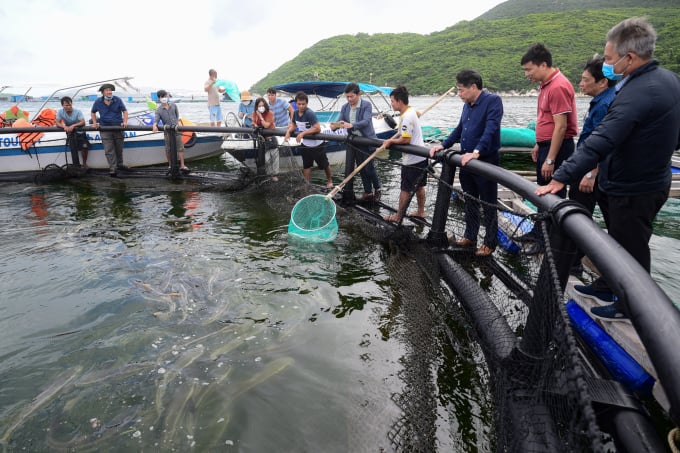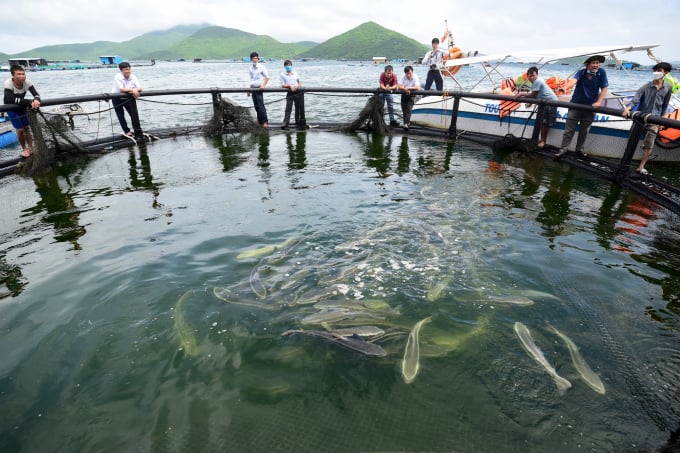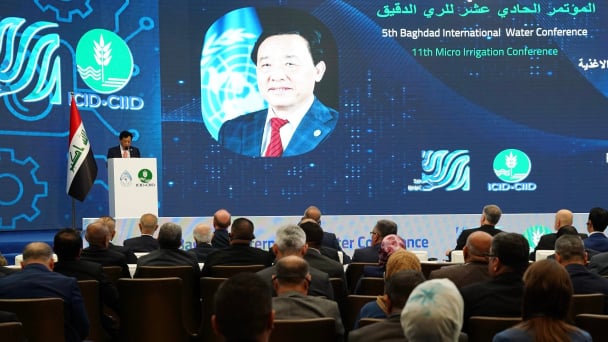May 29, 2025 | 16:16 GMT +7
May 29, 2025 | 16:16 GMT +7
Hotline: 0913.378.918
May 29, 2025 | 16:16 GMT +7
Hotline: 0913.378.918
Hurricane No. 12 has caused very heavy damage to seafood farmers with wooden cages in Khanh Hoa, and the weather is becoming more complicated, hurricanes and storms occur more frequently. The problem is how to help farmers change production methods to both adapt to natural disasters and ensure effective economic benefits.

Models of HDPE cage and traditional wooden cage. Photo: KS.
With this problem, Khanh Hoa Agricultural Extension Center researched, surveyed and was supported by the National Center for Agricultural Extension to implement the project "Building a model of raising cobia using Norwegian HDPE round cages” in the province.
The aforementioned project is implemented from 2020 and ends in 2022, with a scale of 6 HDPE cages. In which, in 2020, the model has built 1 cage, in 2021, 2 cages has been built and in 2022 3 cages will be deployed. From there, this project serves a basis to help aquaculture farmers on Van Phong Bay and farmers across the province learn and change the method of marine farming from traditional wooden cages to HDPE cages.

The model of raising cobia in HPDE cage is deployed in Van Phong bay, Khanh Hoa province. Photo: LK.
After 2 years of implementation, we acknowledged that in Bai Tranh farming area, in Van Phong bay, Van Ninh district (Khanh Hoa), HDPE round cages were applied by farmers with positive effects.
As an aquaculture farmer with over 20 years of experience, with a household that suffered heavy damages due to Hurricane No. 12, losing billions of dong, Mr. Nguyen Xuan Hoa, from Van Gia town (Van Ninh) approved wholeheartedly when the project helped farmers change to new production methods. Therefore, at the beginning of 2020, he pioneered to spend 30% of counterpart capital to experiment with raising cobia in HDPE cages.
Since then, Mr. Hoa has raised cobia in round cages for 2 litters to harvest. In which, for the first litter, he released 1,000 fish, after 7 months of farming, he harvested 903 fish, with an average weight of 5kg/fish. However, due to the impact of the Covid-19 pandemic, the price of fish dropped, he was only able to trade for 130,000 VND/kg (average 150,000 VND/kg), but after deducting costs, he still made a profit of about 100 million VND.
As for the second litter, he released 3,000 fish and obtained 6 tons at the end of 2021, selling for 120,000 VND/kg, he made a profit of 130 million VND. Currently, the third litter, Mr. Hoa continues to release 4,000 cobia which are growing and developing very well.
Regarding the efficiency of raising in HDPE cages, according to Mr. Hoa, fish grow and develop well thanks to the well-ventilated cages, survival rate of fish reaches 80-90%, 15-20% higher than in traditional cages. Particularly, with the number of 3,000 fish raised in wooden cages as before, it would have required 4 workers, but now after switching to HDPE cages, only 2 workers are needed.

Mr. Tran Ngoc Sy (left) said that ever since he started applying HDPE cage farming, he no longer fears that hurricanes will cause economic damage. Photo: KS.
Similarly, from 2021, when Mr. Tran Ngoc Sy, in Van Luong commune (Van Ninh) applied cobia farming in HDPE round cages, he also found satisfactory results. According to Mr. Sy, in addition to helping to increase the survival rate of fish by 15% compared to that of wooden cages, raising in HDPE cages also helps the farming process limit diseases significantly.
Meanwhile, technical-wise, raising fish in HDPE cages is not much different from raising fish in wooden cages. The cage has a moderate volume, so it only requires 2 people to operate. Because the taking care and harvesting of fish are completely manually, by pulling the ropes up and down as needed, then using a racket to catch fish, no need for sophisticated machinery.
In particular, when we asked Mr. Hoa and Mr. Sy ever since switching to HDPE cages, during the rainy season, they said that they were no longer afraid of the cages being destroyed, causing economic losses. Therefore, these farmers expected to replicate the HDPE cage model in the near future.
Cages are produced in Vietnam, costs are reduced by over half compared to imported cages
Mr. Hoa said, HDPE cage is different from the traditional square cage made of wood and bamboo with the size of 4x4m, in that HDPE cages are round in shape, 10m in diameter, 500m3 in cage volume. This round cage is easy for farmers to stand on top of the frame as well as move around in the cage, with a load capacity of about 30 people. Especially, the outstanding advantage of this HDPE model is that it does not corrode, rust and has high flexibility, so it is easy to shape and does not break when encountering rough or bumpy terrain. Because the cages are made in Vietnam, the purchase price is only 180 million VND, less than half of the imported Norwegian cage.
Mr. Huynh Kim Khanh, Director of Khanh Hoa Agricultural Extension Center, said that after the project started implementing the HDPE cage farming model, it has brought remarkable results. Specifically, in addition to the benefits of protecting the environment, limiting deforestation to make wood for cages, the model also helps farmers adapt to natural disasters, eliminating the fear of damaging hurricanes. Moreover, the cages are well ventilated, helping fish grow and develop well, limiting diseases and the environmentally friendly, as well as increase fish productivity significantly.

Installing HDPE round cages manufactured by Vietnamese businesses. Photo: KS.
According to Mr. Khanh, raising fish in wooden cages yields less than 10kg fish/m3, but the yield in HDPE cages can reach 15kg fish/m3. Moreover, the durability of the HDPE cages as well as the total cost in a culture cycle until the cage breaks down is still cheaper than that of wooden cages.
Because a wooden cage with the size of 4x4x5m, volume of 80m3 with the investment cost of 10 million/cage but the life span lasts only 5 years. But with a HDPE round cage, with a diameter of 10m, a volume of about 500m3, equal to about 5 wooden cages, but the life span is over 20 to 30 years. Therefore, within 20 years, raising in 5 wooden cages would cost over 200 million VND while raising in HDPE cages would cost only 180 million VND.

The implementation of HDPE cage farming will bring many benefits such as reducing deforestation in making wooden cages, adapting to climate change and the environment. Photo: KS.
However, the reason why farmers still prefer wooden cages is because the cycle is short, so the initial cost is low. Meanwhile, their capital is small, so they want to invest a few wooden cages every year, they don't have enough money to invest once. However, if calculating the dual benefits as mentioned above, the farmer's investment in HDPE cages will be a much better choice than wooden cages.
Moreover, in the past, Norwegian-style cage technology was applied by Vietnamese farmers, but the cage price was very high, beyond the ability of fishermen. However, currently, in order to have suitable cages, Vietnamese businesses have researched and changed supplies, materials to suit the conditions of Vietnam. As a result, the price per HDPE cage is lower than that of Norwegian imported cages by more than half. The cage durability is over 20 years, if farming is effective after only 3 years, capital will be recovered.
Also according to Mr. Khanh, with the effectiveness of the HDPE cage farming model, currently, aquaculture farmers in Van Phong Bay are very interested in studying and following. Since then, farmers have expanded to over 30 HDPE cages, exceeding the project's target.
Need to replicate the model of marine farming with HDPE cages
Pham Ngoc Luyen, Deputy Head of Van Ninh districtEconomic Division said, currently, the whole district has about 39,000 cages belonging to over 1,200 households engaged in marine aquaculture. Most of the cage systems are wooden rafts with the main species raised being cobia, pompano, grouper, lobster... The HDPE round cage farming model piloted by the Van Ninh Provincial Agricultural Extension Center is more resistant to wind and storms than traditional wooden cages, thereby protecting fishermen's property. In particular, through the model, staffs of the Agricultural Extension Center of the province, district have supported and discussed with fishermen in a timely manner, handled technical issues and farming process, so it has achieved high efficiency.
With economic benefits and sustainability, the District Economic Department encourages people to gradually switch from traditional wooden cage farming to HDPE cage farming to reduce risks and disasters when hurricanes occur. As well as proposing Khanh Hoa Provincial People's Committee, the Department of Agriculture and Rural Development and the Provincial Agricultural Extension Center to continue facilitate the building and replicating of the marine aquaculture using HDPE cages models in the locality. The Provincial People's Committee is interested in promptly promulgating a policy to support marine aquaculture using HDPE cage technology and a roadmap to support fishermen convert cages using traditional materials to cages using new HDPE materials.
Translated by Nguyen Hai Long

(VAN) FAO’s Director-General addresses the 5th Baghdad International Water Conference.
/2025/05/26/1716-4-nongnghiep-191706.jpg)
(VAN) Chain linkages, technological innovation, and raw material zoning are three strategic pillars for the coconut industry to strongly develop and elevate its position on the global agricultural map.
![Advanced mariculture – an inevitable trend: [4] Accompanied by scientists](https://t.ex-cdn.com/nongnghiepmoitruong.vn/608w/files/sohk/2025/05/13/1941-pgsts-vo-van-nha-140958_717.jpg)
(VAN) According to Assoc. Prof. Dr. Vo Van Nha, Director of the RIA III, the development of advanced offshore mariculture is no longer an option but an essential path for Vietnam’s fisheries sector.

(VAN) Vietnam is intensifying the development of mollusk farming areas that meet international standards, aiming for sustainable growth and enhancing its export position in the global seafood market.
![Advanced mariculture – an inevitable trend: [3] Policy-driven momentum](https://t.ex-cdn.com/nongnghiepmoitruong.vn/608w/files/doanhtq/2025/05/21/0104-0616-0348-nuoi-bien-170339_789.jpg)
(VAN) To ensure the success of offshore mariculture that uses advanced technologies, it is essential to establish supportive policies that inspire both individuals and enterprises to invest with confidence.
![Advanced mariculture – an inevitable trend: [2] Outstanding results](https://t.ex-cdn.com/nongnghiepmoitruong.vn/608w/files/sohk/2025/05/12/4632-4136-nuoi-bien-11-164117_819.jpg)
(VAN) Pilot models of high-tech offshore mariculture in Vietnam, particularly in the South Central Coast region, have demonstrated exceptional economic returns and sustainability, setting a new direction for the country’s aquaculture industry.
![Advanced mariculture – an inevitable trend: [1] Moving offshore](https://t.ex-cdn.com/nongnghiepmoitruong.vn/608w/files/phucpm/2025/05/18/0252-2436-nuoi-bien-6-162148_783.jpg)
(VAN) Mariculture using advanced technology and moving offshore is an inevitable trend, as nearshore areas increasingly reveal limitations.